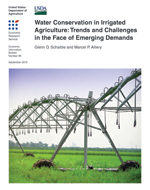Water Conservation in Irrigated Agriculture: Trends and Challenges in the Face of Emerging Demands
- by Glenn Schaible and Marcel Aillery
- 9/4/2012
Overview
This report relies on findings from several national surveys and current literature to assess water resource use and conservation measures within the U.S. irrigated crop sector. U.S. agriculture accounts for 80-90 percent of the Nation's consumptive water use (water lost to the environment by evaporation, crop transpiration, or incorporation into products). Expanding water demands to support population and economic growth, environmental flows (water within wetlands, rivers, and groundwater systems needed to maintain natural ecosystems), and energy-sector growth, combined with Native American water-right claims and supply/demand shifts expected with climate change, will present new challenges for agricultural water use and conservation, particularly for the 17 Western States that account for nearly three-quarters of U.S. irrigated agriculture. Despite technological innovations, at least half of U.S. irrigated cropland acreage is still irrigated with less efficient, traditional irrigation application systems. Sustainability of irrigated agriculture will depend partly on whether producers adopt more efficient irrigation production systems that integrate improved on farm water management practices with efficient irrigation application systems.
Download
-
Entire report
Download PDF -
Report summary
Download PDF -
Download EIB99.zip
Download ZIP

